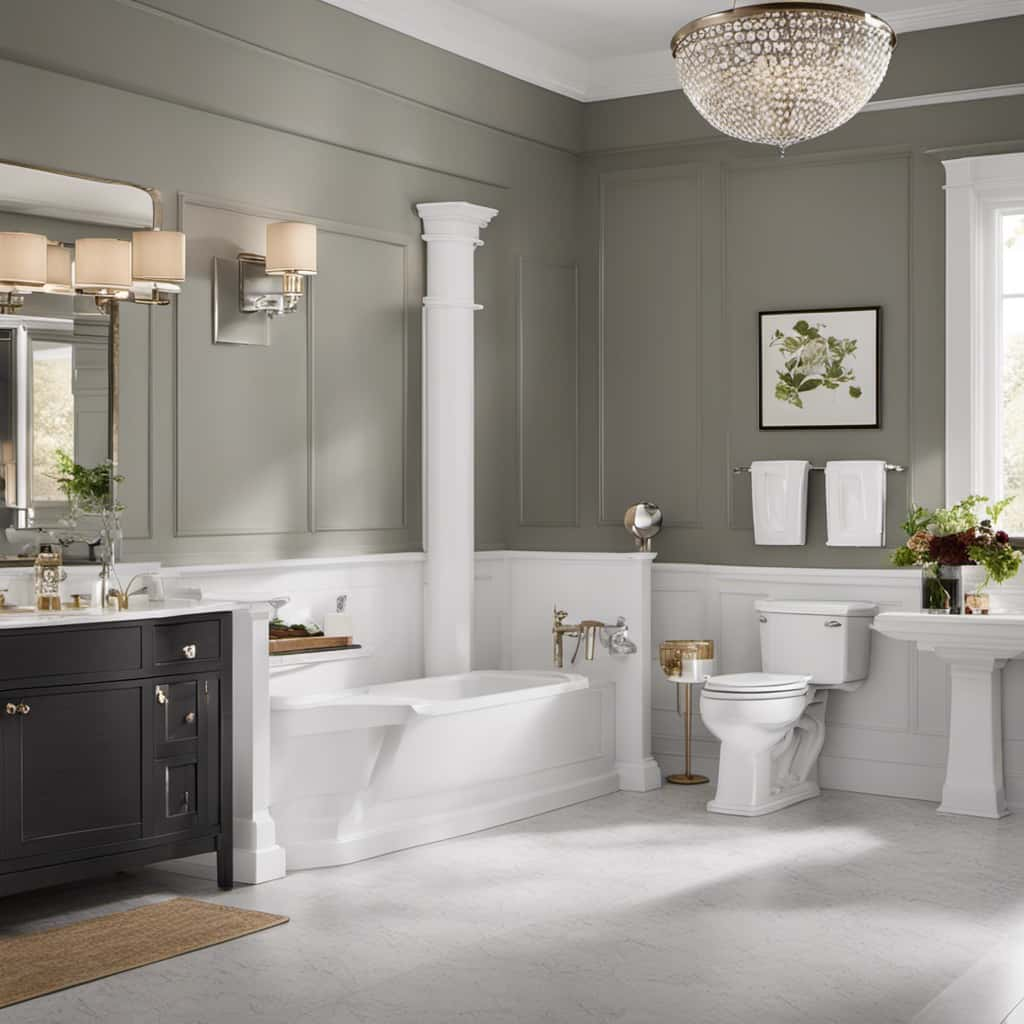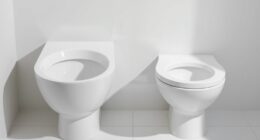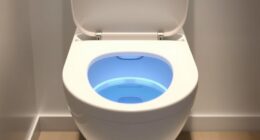Can I really flush the toilet when the water is off? It’s a question that may have crossed your mind during a water outage or plumbing issue. Well, the answer might surprise you.
In this article, I’ll delve into the fascinating world of toilet flushing mechanisms and explore alternative methods that can be used when the water supply is cut off.
So, if you’ve ever wondered about the possibility of flushing without running water, buckle up and get ready for some eye-opening insights.
Key Takeaways
- Flushing alternatives like bucket flush, dual-flush toilets, composting toilets, vacuum toilets, and portable sanitation systems can be used during water outages.
- Flushing without water can lead to risks such as potential blockages in the plumbing system, damage to the toilet, unavailability of traditional flushing methods, inconvenience caused by water shortage, and the need for alternative sanitation methods.
- Alternative methods for flushing without water include manual flushing with a bucket of water, dry toilets like composting or incinerating toilets, greywater recycling systems, water-saving habits, and portable sanitation solutions.
- Expert advice for water shortages includes installing composting toilets, using greywater recycling systems, implementing water-saving habits, considering portable sanitation solutions, and seeking advice from experts for alternative sanitation methods.
Is It Possible to Flush the Toilet Without Running Water
Yes, it’s possible to flush the toilet without running water by using a bucket of water.
In situations where the water supply is temporarily unavailable or disrupted, alternative flushing methods become essential.
One of the most common emergency toilet options is the bucket flush. To execute this method, you simply pour a bucket of water directly into the toilet bowl. The force of the water displaces the waste and initiates the flushing process.
It’s important to pour the water quickly and with enough force to ensure a proper flush. Additionally, you may need to repeat the process a couple of times to fully clear the bowl.
While this method may not be as convenient as a regular toilet flush, it serves as a practical solution during water scarcity or emergencies.
Understanding the Flushing Mechanism and Its Reliance on Water Supply
The flushing mechanism won’t work properly if the water supply is turned off.
Understanding how the flushing mechanism works is essential for DIY toilet hacks and water conservation techniques.
When you press the flush lever, it lifts the flapper valve, allowing water from the tank to rush into the bowl. This sudden rush of water creates a siphoning effect, which pulls waste and water out of the bowl and into the drain.
Without a steady supply of water, the flushing mechanism cannot create the necessary siphoning action.
To conserve water, you can consider using dual-flush toilets, which have two flushing options for liquid and solid waste.
Additionally, you can place a water-saving device in the toilet tank to reduce the amount of water used per flush.
Alternative Methods for Flushing the Toilet During a Water Outage
When faced with a water outage, it’s important to have alternative methods for flushing the toilet.
One option is to use a no-water toilet, such as a composting toilet or an incinerating toilet, which don’t rely on water for flushing.
Another option is to utilize DIY flushing techniques, such as filling a bucket with water and pouring it into the toilet bowl to simulate a flush.
These methods can help ensure proper sanitation and hygiene during a water outage.
No-Water Toilet Options
If the water is off, you can use alternative options for flushing the toilet. In situations where water is scarce or not available, it’s important to know about water-saving toilet options.
One such option is a composting toilet. These toilets use little to no water and rely on natural processes to break down waste. They can be a great choice for off-grid living or during water shortages.
Another option is a dual-flush toilet. These toilets have two flushing options: a full flush for solid waste and a half flush for liquid waste, saving water with each use.
Additionally, you can consider installing a greywater recycling system, which reuses water from sinks, showers, and washing machines to flush the toilet.
By exploring these DIY toilet hacks and water-saving toilet options, you can be prepared for situations where water is not readily available.
Now, let’s dive into some DIY flushing techniques.
DIY Flushing Techniques
To conserve water during times of scarcity, consider trying out these DIY flushing techniques. Here are four simple methods that can help you with emergency sanitation when the water is off:
-
Bucket Flush: Fill a bucket with water and pour it directly into the toilet bowl to create enough force to flush waste away.
-
Greywater Flushing: Reuse greywater, such as water from dishwashing or laundry, to flush the toilet. This helps to reduce water wastage.
-
Dual-Flush Conversion: Install a dual-flush kit in your toilet to have control over the amount of water used for flushing. This allows you to conserve water during times of scarcity.
-
Composting Toilet: Consider installing a composting toilet as a long-term solution. These toilets use little to no water and convert waste into compost, making them environmentally friendly.
These DIY plumbing techniques can be valuable during emergencies or when water is scarce, ensuring proper sanitation without wasting precious resources.
Pros and Cons of Using Non-Traditional Flushing Techniques
Using non-traditional flushing techniques has its pros and cons. When it comes to DIY toilets and water saving options, there are a few things to consider.
On the positive side, using non-traditional flushing techniques can help conserve water, which is not only environmentally friendly but can also reduce your water bills. DIY toilets often have options for dual flushes, allowing you to choose between a full flush and a partial flush, depending on your needs. This can save a significant amount of water compared to traditional toilets.
However, there are also drawbacks to non-traditional flushing techniques. They may not be as reliable or efficient as traditional toilets, and they may require more maintenance and repairs.
It’s important to weigh the benefits and drawbacks before deciding if non-traditional flushing techniques are right for you.
Important Considerations When Attempting to Flush the Toilet Without Water
When it comes to flushing the toilet without water, there are several important considerations to keep in mind.
Firstly, it is crucial to understand the risks associated with attempting this method, as it can potentially lead to plumbing issues or damage.
Secondly, exploring alternative options such as composting toilets or portable sanitation systems may be a more practical and sustainable solution.
In order to make an informed decision and ensure the safety of your plumbing system, it is advisable to seek expert advice from a professional plumber or wastewater specialist.
Flushing Without Water
You can’t flush the toilet without water. It’s a simple fact of life. However, when faced with a water shortage or a plumbing issue, knowing some flushing alternatives can be incredibly useful. Here are four options to consider:
-
Bucket flush: Fill a bucket with water and pour it forcefully into the toilet bowl. This can create enough pressure to push waste down the drain.
-
Dual-flush toilets: These innovative fixtures have two buttons or handles, allowing you to choose between a full flush for solid waste and a half flush for liquid waste. This can help save water in the long run.
-
Composting toilets: These toilets use natural processes to break down waste into compost. They require little to no water and are an environmentally friendly option.
-
Vacuum toilets: Commonly used on airplanes and trains, vacuum toilets use air pressure to remove waste. They are highly efficient and require minimal water.
Risks and Alternatives
Consider the risks and explore alternative options to ensure proper sanitation and waste disposal. Flushing without water can pose several risks, such as the potential for blockages in the plumbing system or damage to the toilet itself.
When the water is off, flushing with traditional methods becomes impractical. However, there are alternative methods that can be used to maintain sanitation.
One option is to use a bucket of water to manually flush the toilet by pouring it directly into the bowl.
Another alternative is to use dry toilets, like composting toilets or incinerating toilets, which do not require water for flushing.
These alternative methods not only eliminate the risks associated with flushing without water, but they also offer additional benefits such as water conservation and reduced reliance on infrastructure.
Expert Advice Needed
Seeking advice from experts can provide valuable insights on finding alternative methods for maintaining sanitation and waste disposal when facing water shortages. Here are four expert opinions and troubleshooting tips that can help you navigate through this challenging situation:
-
Install a composting toilet: This eco-friendly option eliminates the need for water and safely converts waste into compost.
-
Use greywater recycling systems: These systems collect and treat water from showers, sinks, and laundry, making it suitable for flushing toilets.
-
Implement water-saving habits: Simple actions like flushing only when necessary, using a reduced flush option if available, and fixing any leaks can significantly reduce water usage.
-
Consider portable sanitation solutions: Portable toilets and waste disposal bags can be handy during emergencies or temporary water shortages.
By following these expert opinions and troubleshooting tips, you can find alternative methods for maintaining sanitation and waste disposal during water shortages.
Now, let’s explore some tips and tricks for maintaining hygiene during a water shortage.
Tips and Tricks for Maintaining Hygiene During a Water Shortage
If the water is off, can’t flush the toilet?
When faced with a water shortage, it may seem impossible to maintain proper toilet hygiene. However, there are a few tips and tricks that can help in this situation.
Firstly, it is important to conserve water by only flushing when absolutely necessary. This means only flushing solid waste and using a bucket of water to manually flush if needed.
Another option is to use alternative hygiene methods, such as dry toilet paper or wet wipes, followed by proper disposal in a waste bin.
Additionally, practicing good personal hygiene, like washing hands with hand sanitizers or wet wipes, can help prevent the spread of germs.
Conclusion
In conclusion, while it may seem impossible to flush a toilet without running water, there are alternative methods that can be used during a water outage.
One example is using a bucket of water to manually pour into the toilet bowl, which can generate enough force to flush waste away. This technique has been successfully used in emergency situations, such as during natural disasters or plumbing issues.
It is important to remember that maintaining hygiene during a water shortage requires resourcefulness and adaptability.










